How to Write Alt Text for an Image
Excel for Microsoft 365 Word for Microsoft 365 Outlook for Microsoft 365 PowerPoint for Microsoft 365 Office 2021 Office 2021 for Mac Office 2019 Office 2019 for Mac Office 2016 Office 2016 for Mac Office 2013 SharePoint in Microsoft 365 Sway More...Less
If a picture is worth a thousand words, what is it worth to people who cannot see? In our digital world, it is easy for people with visual impairments to miss critical information or have a frustrating and negative experience. Imagine, for example, that a keynote speaker sends out their presentation after a conference. The presentation contains infographics to illustrate a key point. Without descriptions of the infographics, anyone with a visual impairment cannot understand the infographic and misses out on key information.
Alternative text (alt text) is descriptive text which conveys the meaning and context of a visual item in a digital setting, such as on an app or web page. When screen readers such as Microsoft Narrator, JAWS, and NVDA reach digital content with alt text, they will read the alt text aloud, allowing people to better understand what is on the screen. Well-written, descriptive alt text dramatically reduces ambiguity and improves user experience.
People hear words objectively, but understand them subjectively. This topic describes how to understand, write, and use effective alt text in Microsoft Office products.

When to use alt text?
Images and pictures
Make sure to convey the content and the purpose of an image in a concise and unambiguous manner. The alt text shouldn't be longer than a sentence or two—most of the time a few thoughtfully selected words will do. Consider what is important about an image. For example, important context may be the setting, the emotions on people's faces, the colors, or the relative sizes.
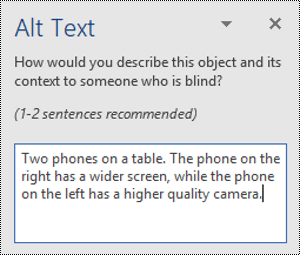
Do not repeat the surrounding textual content as alt text or use phrases referring to images, such as, "a graphic of" or "an image of." In the example below, the alt text is referring to the image and does not describe the content of the image sufficiently.

Diagrams, flow charts, and charts
When dealing with objects that give detailed information, such as an infographic, use alt text to provide the information conveyed in the object. Describing a chart as 'A bar chart showing sales over time', for example, would not be useful to a blind person. Try to convey the insight; for example, 'A bar chart showing sales over time. In July, sales for brand A surpassed sales for brand B and kept increasing throughout the year.'
Alt text should clearly describe the beginning point, progress, and conclusion of flow charts.
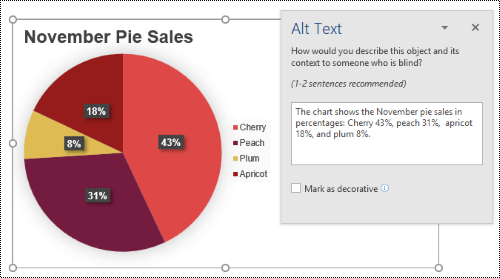
Videos
Videos that don't explain their content require alt text to describe the visual experience, even if the user hears music, background sounds, and speech. Alt text should describe the content and purpose of the video.
Ideally, a video should contain a second audio track with a description of the video elements that are purely visual and not accessible to visually-impaired people.
When not to use alt text?
Decorative visual objects
Decorative objects add visual interest but aren't informative (for example, stylistic borders). People using screen readers will hear these are decorative so they know they aren't missing any important information. To mark a visual as decorative, simply select the Mark as decorative check box when the Alt Text pane is open. The text entry field becomes grayed out.
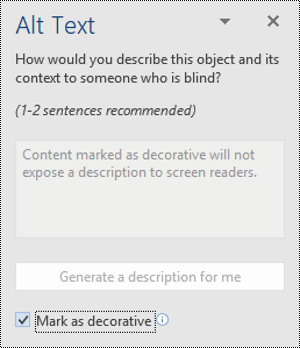
Tip:If you export your document as a PDF, any visuals you have marked as decorative will be automatically tagged as artifacts, which means they will be ignored by screen readers when navigating through PDFs.
Slicers and tables
If the Microsoft Office Accessibility Checker doesn't flag an object when it's missing alt text, you don't have to write alt text for it. Slicers and tables are examples of these objects.
How to add alt text to an object?
-
Do one of the following:
-
Right-click the object and select Edit Alt Text.
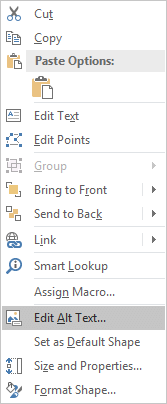
-
Select the object. Select Format > Alt Text.
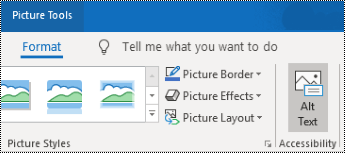
-
-
In the Alt Text pane, type 1-2 sentences in the text box to describe the object and its context to someone who cannot see it.
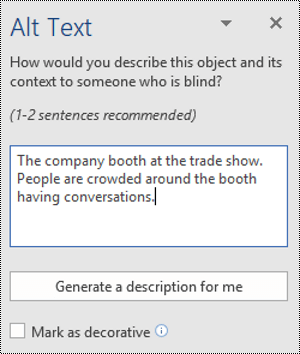
Tips for using alt text in Microsoft Office
-
Remember to use the Microsoft Office Accessibility Checker during your review process. It checks that all relevant visual content has alt text and also gives you other suggestions for improving the accessibility of your content, such as checking contrast ratios. To run the Accessibility Checker, simply click the Review tab on the ribbon, and then click Check Accessibility. For more info on the Accessibility Checker, go to Improve accessibility with the Accessibility Checker.
-
Do not use a file name, duplicate text, or URLs as alt text. The Accessibility Checker will flag these since they are not useful to someone with a visual impairment. For more info, go to Rules for the Accessibility Checker.
-
If there is a group of objects that forms a semantic group, such as a group of photos that all show dogs, assign alt text for the whole group. If objects have been grouped together for formatting reasons, ungroup the objects and assign appropriate alt text for each object.
Tip:To spell check and correct a word you typed in the Alt Text pane, just right-click the word and select from the suggested alternatives.
Note:If you have used Microsoft Office for a while, you might have noticed that the Alt Text pane used to have two fields, Title and Description. Now we use a single Description field—it has been found that having a single field is easier and less confusing for both you as the author and also anyone using a screen reader to consume the content.
Automatic alt text
In Microsoft 365, alt text can be generated automatically. When you insert a picture, you may see a bar show up at the bottom of the picture with automatically generated alt text.
In Office 2019, alt text is not generated automatically when you insert an image. If you want to add automatic alt text, select the Generate a description for me button in the Alt Text pane. Depending on the content of the image, sometimes the feature gives you descriptive tags and sometimes you get full sentences.
If automatic alt text is generated, remember to review and edit it in the Alt Text pane and remove any comments added there such as "Description generated with high confidence."

Turn automatic alt text on
Before you can use automatic alt text, you must enable Office Intelligent Services in any Office product.
-
Select File > Options > General and check that Enable services is selected under Office intelligent services.
-
Select the Ease of Access tab and check that Automatically generate alt text for me is selected under Automatic Alt Text.
Turn automatic alt text off
-
Select File > Options > Ease of Access and unselect the Automatically generate alt text for me option under Automatic Alt Text.
Where to find alt text functional guidelines
Get additional resources to help you write effective alt text:
-
Improve accessibility with the Accessibility Checker
-
Rules for the Accessibility Checker
-
Make your Word documents accessible to people with disabilities
-
Make your Excel documents accessible to people with disabilities
-
Make your OneNote notebooks accessible to people with disabilities
-
Make your Outlook email accessible to people with disabilities
-
Make your PowerPoint presentations accessible to people with disabilities
-
Make your Project Online sites and projects accessible to people with disabilities
-
Make your SharePoint site accessible to people with disabilities
-
Make your Sway design accessible to people with disabilities
-
Make your Visio diagram accessible to people with disabilities
-
For more information on how to ensure that Microsoft Office products and user experiences meet the requirements for accessibility, visit our accessibility sites An inclusive Microsoft 365 and Make your content accessible to everyone with the Accessibility Checker.
Need more help?
How to Write Alt Text for an Image
Source: https://support.microsoft.com/en-us/topic/everything-you-need-to-know-to-write-effective-alt-text-df98f884-ca3d-456c-807b-1a1fa82f5dc2
0 Response to "How to Write Alt Text for an Image"
Post a Comment